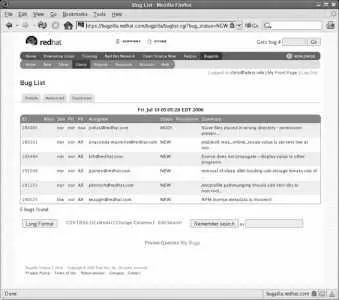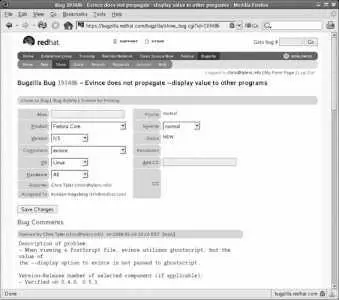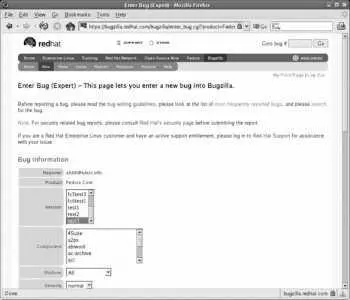Figure 9-8. Query results

Figure 9-9. Bug detail page

If your query produces no matches, Bugzilla will helpfully inform you that "Zarro boogs" were found.
9.3.1.1. Creating a Bugzilla account
In order to add to the comments on existing bugs or to report new bugs, you must have a Bugzilla account. To create an account, click the New Account link in the upper-right corner of the page, and then enter your email address and your full name.
You may want to use a disposable email address because the address will be made public (see Lab 7.6, "Configuring the sendmail Server," for more on disposable email addresses).
Bugzilla will send you an email containing a temporary password:
From: bugzilla@redhat.com
To: jdoe@fedorabook.com
Subject: Your Bugzilla password.
Date: Fri, 14 Jul 2006 05:37:36 -0400
To use the wonders of Bugzilla, you can use the following:
E-mail address: jdoe@fedorabook.com
Password: J8sCuid79D
To change your password, go to:
https://bugzilla.redhat.com/bugzilla/userprefs.cgi
Follow the link in the email to set your password to a sane value. When you revisit Bugzilla, you can log in to your account using your email address and password.
9.3.1.2. Reporting a new bug
If you have searched for reports of a particular issue and have not found any existing bugs, you can open a new bug report by clicking the New tab in the gray bar. You will be presented with a list of products, as shown in Figure 9-10 ; select the appropriate one from the Fedora portion of the list.
Figure 9-10. Bugzilla product list

Bugzilla will then present you with the main bug-entry form, as shown in Figure 9-11. Select the product version that you are using, and then select the component (package).
Figure 9-11. Bugzilla new bug-detail form

If the package you want is not in the component list, you may have selected the wrong productfor example, you may have selected Fedora Core for a package that is actually in Fedora Extras. Use the Back button on your browser to return to the product list and try another product.
Select a platform and severity (the default is usually correct for both), and then enter a summary (title) for the bug. Choose one that succinctly describes the bug.
Now enter the bug Description. Use as many of the preplaced headings as possible ("Description of problem," "How reproducable," "Steps to reproduce," "Expected results," "Actual results"). Ideally you should provide clear, step-by-step instructions that will reliably provoke symptoms that demonstrate the bug, as well as any relevant details about your system and use context.
You also have the options of attaching a file (such as a configuration file or logfile) and marking the bug as a security-sensitive bug, which is not posted publicly.
Click on Submit to file the bug report. You will be given a Bugzilla bug number that will enable you to rapidly find the bug for follow-up in the future.
Each bug has a status that is initially set to New. This status will change as the bug is reviewed, assigned, commented upon, and eventually resolved. Each time a comment is added or the status changes, you will receive an email.
Bugzilla was written by the Mozilla project to track bugs in the Mozilla browser and related software. It has since been adopted (and adapted) by a number of other open source projects, including the GNOME and KDE desktops. It's written in Perl, uses Apache for the web server, and can be used with either a MySQL or PostgreSQL database for bug storage and tracking.
9.3.3.1. ...receiving less (or more) email from Bugzilla?
If you log in to Bugzilla and select the Account tab, you will see a preferences screen (which in turn has an E-mail tab). In that page, you will find controls that let you fine-tune the circumstances under which Bugzilla will send you email.
9.3.3.2. ...a bug that's not really a bug?
You can add a comment to an existing bug that you have created and change its status. For example, if you find out that a bug that you reported is actually correct behavior, you can close the bug as resolved, setting the resolution indicator to NOTABUG. In your comment, you can explain the reason for the status change.
9.3.3.3. ...a bug due to problems in the upstream code?
Since Fedora is a distribution , most of the code comes from other projects (such as GNOME, Apache, and OpenOffice.org). In many cases, the resolution of a bug will really be the responsibility of the upstream project.
If you know that a particular problem is due to a code defect or issue with the underlying program code, rather than Fedora's packaging of that code or the interaction of that code with other Fedora packages, it is a good idea to register the bug in that project's Bugzilla database and add a cross-reference to the Fedora bug record. To facilitate this, there is a control labeled External Bug References on the Bugzilla entry screen; select the upstream Bugzilla system from the pull-down list and enter the bug number from that system.
9.3.3.4. ...referring to a Bugzilla bug on the mailing lists or in IRC?
By convention, numbers prefixed with "BZ" are interpreted as Bugzilla numbers.
9.3.4. Where Can I Learn More?
The Fedora Bugzilla Reporting Guidelines: http://fedoraproject.org/wiki/BugsAndFeatureRequests
The Red Hat Bugzilla help page: https://bugzilla.redhat.com/bugzilla/page.cgi?id=redhatfaq.html
The home page of the Bugzilla project: http://www.bugzilla.org/
If you're interested in seeing the evolving future shape of Fedora Core and assisting with testing, you can run Rawhide, the constantly changing development version of Fedora Core.
First, a warning is in order. As the original Rawhide announcement noted:
Raw Hide Can Be a Bit Tough to Chew on So Run at Your Own Risk (and Enjoyment)
These releases have not been quality tested by Red Hat's Quality Assurance team. They may not boot. If they boot, they may not install. If they install, they may not do anything other then waste CPU cycles. If anything breaks, you most assuredly own the many fragments which will be littered across your floor.
It may not be possible to upgrade from Fedora Core to Raw Hide, from Raw Hide to Fedora Core, or from Raw Hide to Raw Hide! If a stable upgrade path is important to you, please do not use Raw Hide.
DO NOT USE THESE RELEASES FOR ANY WORK WHERE YOU CARE ABOUT YOUR APPLICATION RUNNING, THE ACCURACY OF YOUR DATA, THE INTEGRITY OF YOUR NETWORK, OR ANY OTHER PURPOSE FOR WHICH A RESPONSIBLE HUMAN WOULD USE A COMPUTER. (But then again what would be the fun of hacking Linux if there wasn't some risk involved. ;-)....)
Читать дальше
















